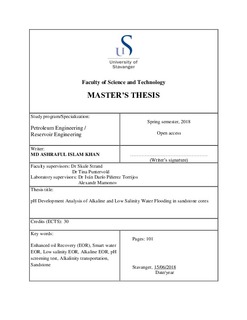pH Development Analysis of Alkaline and Low Salinity Water Flooding in sandstone cores
Master thesis
Permanent lenke
http://hdl.handle.net/11250/2569902Utgivelsesdato
2018-06Metadata
Vis full innførselSamlinger
- Studentoppgaver (TN-IEP) [336]
Sammendrag
Low salinity (LS) water flooding has been in the center of interest for conventional oil recovery in sandstone reservoir for more than two decades because of its low cost and potential for increased oil recovery. Though hundreds of researches have been done on LS EOR method, the mechanism behind the oil recovery is still debatable. Recently, Smart Water group of University of Stavanger has proposed a new chemical wettability alteration mechanism where protons (H+) from LS water replaces metal ions such as Ca2+, Na+ from the clay surface and made the surface more water wet by releasing polar organic oil components due to a pH increase. As a result, more oil is displaced towards production well and increases oil recovery. As the proton (H+) is adsorbed, pH of the produced water is increased and using this theory, Aksulu et. al. (2012) established a pH screening test as an experimental tool to check the LS potential for sandstone.
pH of the system can also be increased by injecting alkaline water of high pH instead of creating in situ pH increase by LS water flooding. In this thesis, the transportability of alkalinity and development of pH was investigated for LS and alkaline water flooding. Three outcrop sandstone cores of different mineralogy were used for 12 pH screening tests at different temperatures. In addition with the pH screening test, pressure changes, density changes and ion chromatography tests were done during the flooding to observed the changes of produced water.
pH-screening tests with alkaline water injection showed low potential for extra alkalinity compared with LS water injection. Almost two pH unit of injected high alkaline water is reduced by the minerals and formation water. On the other hand, the results of the pH-screening tests for LS water injection showed a potential for increasing the effluent LS water pH up to two units in comparison to its initial pH-value. Both the LS and alkaline water showed same trend of pH buildup though they had a big difference in bulk pH (almost 5 pH unit). Transportation of alkalinity through a mineral system with large surface area seemed to be challenging due to pH buffering from brine/mineral interactions as well as from chemical interactions involving inorganic cations from the formation water.
It can be concluded after the thesis that an in-situ generation of alkaline conditions in the reservoir by injecting LS water seemed to have a larger potential for EOR purposes than transporting alkalinity by injecting high pH alkaline water through the reservoir.
Beskrivelse
Master's thesis in Petroleum Engineering
